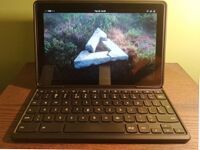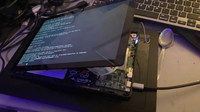Lenovo 10e Chromebook Tablet (google-kodama)
| This device is supported as part of a generic port. Refer to Google Kukui Chromebook (google-kukui) for installation instructions and more information. |
 Lenovo 10e running GNOME | |
| Manufacturer | Lenovo |
|---|---|
| Name | 10e Chromebook Tablet |
| Codename | google-kodama |
| Released | 2020 |
| Type | tablet |
| Hardware | |
| Chipset | MediaTek MT8183 |
| CPU |
4x 2GHz Cortex-A53 4x 2GHz Cortex-A73 |
| GPU | Mali-G72 MP3 |
| Display | 1920x1200 IPS |
| Storage | 32 GB eMMC |
| Memory | 4 GB |
| Architecture | aarch64 |
| Software | |
Original software The software and version the device was shipped with. |
ChromeOS |
Extended version The most recent supported version from the manufacturer. |
ChromeOS |
| postmarketOS | |
| Category | community |
Mainline Instead of a Linux kernel fork, it is possible to run (Close to) Mainline. |
yes |
| Generic port | Google Kukui Chromebook (google-kukui) |
| Device package |
|
| Kernel package |
|
Internal storage eMMC, SD cards, UFS... |
Works
|
|---|---|
Battery Whether charging and battery level reporting work. |
Works
|
Screen Whether the display works; ideally with sleep mode and brightness control. |
Partial
|
Touchscreen |
Works
|
Keyboard Whether the built-in physical keyboard works. |
Works
|
Stylus |
Partial
|
| Multimedia | |
3D Acceleration |
Works
|
Audio Audio playback, microphone, headset and buttons. |
Partial
|
Camera |
Broken
|
| Connectivity | |
WiFi |
Works
|
Bluetooth |
Works
|
| Miscellaneous | |
FDE Full disk encryption and unlocking with unl0kr. |
Partial
|
USB OTG USB On-The-Go or USB-C Role switching. |
Works
|
HDMI/DP Video and audio output with HDMI or DisplayPort. |
Broken
|
| Sensors | |
Accelerometer Handles automatic screen rotation in many interfaces. |
Works
|
Hall Effect Measures magnetic fields; usually used as a flip cover sensor |
Works
|
Users owning this device
Subjective summary
It's a well-supported hardware, the quirks are minor or easy to workaround, however its CPU drags the performance down considerably. It can be daily drived, but do not expect miracles.
Features
Screen
Screen rotation works via accelerometer, but in most cases (on GNOME, SDDM, ...) it's stuck +/- 90 degrees. Issue does not affect Plasma Desktop.
OpenRC-based systems (like Alpine or postmarketOS OpenRC)
Putting
ACTION=="remove", GOTO="sensor_end"
SUBSYSTEM=="iio", KERNEL=="iio*", SUBSYSTEMS=="platform",
ATTRS{modalias}=="platform:cros-ec-accel",
ENV{ACCEL_MOUNT_MATRIX}="0, 1, 0; -1, 0, 0; 0, 0, 1",
GOTO="sensor_end"
LABEL="sensor_end"
inside /etc/udev/rules.d/61-cros-ec-accel.rules
solves the issue
systemd-based systems
Putting
sensor:modalias:* ACCEL_MOUNT_MATRIX=0, 1, 0; -1, 0, 0; 0, 0, 1
inside /usr/lib/udev/hwdb.d/60-sensor.hwdb
and running
sudo systemd-hwdb update && sudo reboot
solves the issue
Stylus
Lenovo USI Pen works well under Plasma Desktop and (assuming you applied screen rotation fix) on Phosh. Other brands of USI pens are expected to work in similar way.
On GNOME, stylus has correct rotation only in one of the portrait orientations. A potential workaround would probably need to apply screen rotation matrix (see udev rules above) in GNOME configuration as well.
External display
Doesn't work under linux yet
USB port
USB-C port is 2.0 - don't expect Thunderbolt docks to work.
FDE
FDE works well, but does not use proper screen orientation, when the keyboard is connected.
Audio
Jack detection doesn't work (can choose manually jack/speaker)
Putting device into suspense (rarely) may result in it generating high pitch noise. Fixing it requires full reboot or in gnome case logging out should do the trick too. Tends to happen less often on newer kernel versions.
Installation
Make sure to use the "tablet" method of enabling developer mode, as the "tablet with keyboard" way will not work.
For some reason, the firmware doesn't have screen output under certain conditions.
To enter developer mode, use the standard key combination used on the Duet (hold both volume buttons and power). Release after ~5 seconds, and you'll see the white power button light turn on and see a black screen. Press both volume buttons at the same time once. Then, press the volume up button (has a + sign) around 10 times. Press the power button once. Wait 5 seconds. A screen should show. You're in dev mode.
Every time you boot up, the developer mode screen should work.
Write-Protection
In case someone is interested in setting GBB flags
Disabling hardware write protection requires temporarily shorting 2 pins (see page nr 32 of manual or purple cable image below) inside the device
Process of opening the device is described in the Hardware Maintenance Manual
